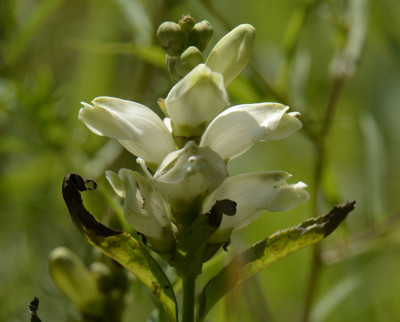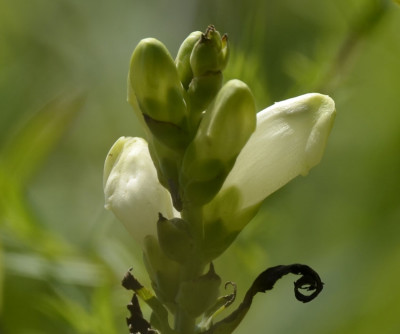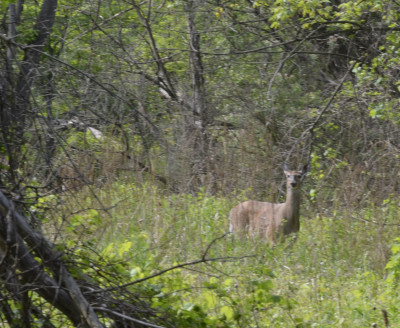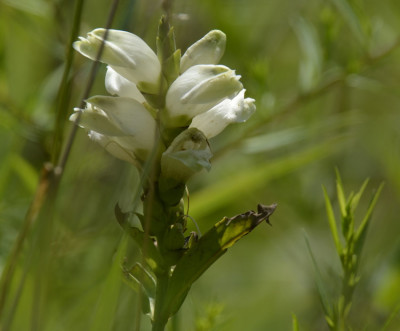Near the end of June this year I found my first Baltimore Checkerspot in Mississauga at the Riverwood Conservancy which protects land along the Credit River. At the time I mentioned I didn’t remember seeing any Turtlehead growing in the area and I would try to spot some later in the summer. And this week while prowling around I did find some White Turtlehead in bloom in the somewhat dried up wetlands along the boardwalk on the Red deer Trail.
Although it’s difficult to see on these plants because the leaves are in distress, Turtlehead’s long narrow spearhead-shaped leaves come in pairs alternating in direction.
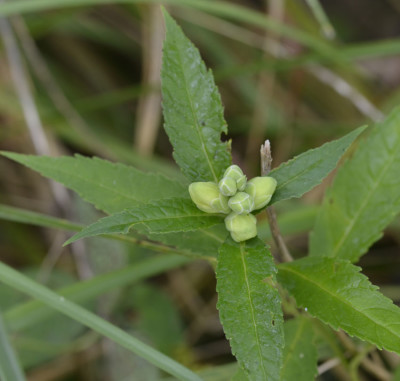
UPDATE: I found this plant close the the path at the Rattray Marsh (August 31) which shows the leaves reasonably clearly.
The only reason I could see the plants at all is that they are tall enough to reach the top of the grasses, reeds, rushes and sedges (and Loosestrife!) in that part of the park. White Turtlehead commonly grows up to a metre in height (2 to 3 feet.)
The individual flowers are quite large about 3 cm (1 inch) in length. You can see that like Snapdragons, they open and finish at the bottom as new flowers develop and open at the top of the stalk.
What Beautiful Butterfly’s Caterpillars Like to Munch on White Turtlehead?
The Baltimore Checkerspot lays eggs on White Turtlehead. I hope to see another one early next summer!
What Pollinates White Turtlehead?
If the shape of the Turtlehead flowers looks vaguely familiar that’s probably because it is in the Snapdragon family. Like Snaps, these flowers are often pollinated by bees such as Bumblebees.
Why Haven’t the Deer Eaten the White Turtlehead?
One problem urban parks often have with native wildflowers is that the White Tailed Deer find them tasty. For instance signage at Riverwood mentions that the Deer have eaten many of the Trilliums. (I do find that a bit puzzling as there are many deer in the Rattray but there are still Trilliums too.) If there were only a few deer they would not damage the plant populations but urban deer populations are often unnaturally large due to the lack of predators and the winter food provided by fond humans.
According to the Illinois Wildflowers Info website, the leaves and stems are bitter tasting and therefore are avoided by deer and other browsing mammals. In an article on the New York State Department of Environmental Conservation website, however, the author says that deer enjoy browsing on the Turtlehead plants in her garden.
I guess it depends on the deer: after all not every human likes eating arugula either.
UPDATE: I just spotted some White Turtlehead in bloom at the Rattray Marsh, near the culvert near Old Poplar Row (August 28, 2015.) Hopefully I’ll see a Baltimore Checkerspot near there some day too!
Related Reading
- What Dark Butterfly Has a Row of Orange and White Spots Along Its Wing Edges in Southern Ontario?
- How to Sex a Monarch. (Butterfly That Is)
- The Ethics of Feeding Deer for Fun and Photos
Join In
Do you have White Turtlehead growing in your local wetland? Have the deer shown any interest in it? Please share your views with a comment.

